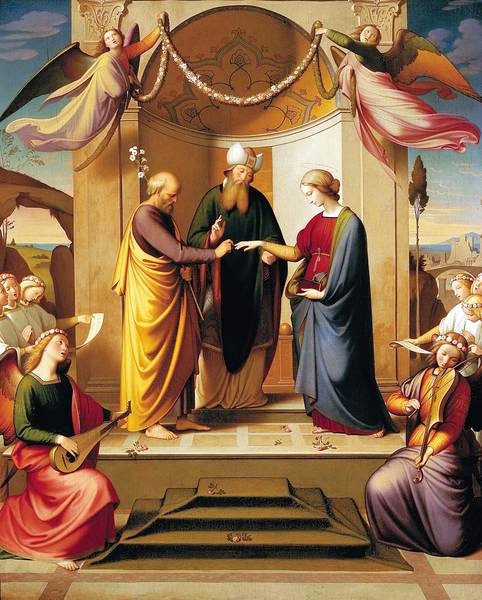While seminary life prevents me from being able to post as often as I used it, it also connects me with a whole world of thoughtful, orthodox Catholic thinkers in the form of professors, formators, and fellow seminarians. I wanted to take a moment to highlight one of them, a fellow barbate seminarian for Kansas City, Kansas: Deacon Nathan Haverland. Below is the homily that he gave this past Sunday at St. Clement of Rome parish, here in St. Louis.
 |
| Deacon Nathan Haverland |
Our readings this Sunday invite us to reflect on the topic of marriage. They are readings that are just as relevant today as they were when they were written. Not long ago Blessed John Paul II used them as the basis for 129 talks given over 5 years in what is called the “Theology of the Body.” There’s a great richness to the readings given to us today.
The Pharisees were out to trick Jesus and so they asked Him if divorce was permissible. By this point, you would think that the Pharisees should have expected that Jesus would not fall into their trap. But they didn’t, and Jesus gave them an answer they never expected. Jesus recognized the law written by Moses, but He invites the Pharisees to look at a law written much earlier: the law written in nature. Yes, the Mosaic Law allowed divorce, He said, but that was because of the hardness of man’s heart. There is law much older than the law of Moses that was not written out of the hardness of man’s heart.
From the very beginning God had a plan for humanity, a plan that He wrote into the very depths of our human nature. Jesus says clearly, “From the beginning of creation, God made them male and female…the two shall become one flesh…what God has joined together, no human being must separate.” Jesus is the Word of God “through whom all things exist.” He is the Word of God that existed from the beginning. Jesus certainly then has authority on the matter of how things were from the beginning.
Jesus explained to the Pharisees that the indissoluble union of a man and woman was always a part of God’s plan. From the beginning, he wrote this plan in the depths of our physical and psychological nature. From the beginning, man has always pointed towards woman, and woman has always pointed towards man. If viewed alone, neither man nor woman make sense. But viewed together, they show that each is designed to be a gift of self to the other. They compliment each other perfectly. From the beginning, God had a plan to unite man and woman so intimately that they would become one flesh, a union that God has bestowed with the capacity of producing new life.
 |
| Johann Friedrich Overbeck, Marriage of the Virgin (1836) |
Marriage has never been easy though. Moses saw this himself. The giving of one’s self to another for a few moments is one thing, but giving of one’s self to another over the course of a lifetime, that is a challenge. Selfishness can easily creep into marriage and slowly eat away at that union made by God. But, it is only in giving of ourselves that we will truly be happy. Selfishness can never bring about happiness.
Why did God write this in our human nature?
A few weeks ago Jesus made big news all around the world. This time, a small fragment from an unknown document, from an unrevealed source, from an uncertain time period, analyzed by a scholar with a questionable intention, just happened to have an incomplete sentence referring to someone named Jesus mentioning a wife. This caused quite a stir all over the world. Could it be that Jesus had a wife?
We don’t have to look any further than the New Testament to see that Jesus did indeed have a Bride. Jesus is the Bridegroom in the New Testament, and the Church is His Bride. Just as Eve was born from the side of Adam, the Church was born from the side of the New Adam, Jesus, on the Cross. Jesus does indeed have a Bride, and at each Mass He gives Himself body, blood, soul, and divinity to His Bride. This intimate union of God with man is what marriage has always foreshadowed. Here, at the altar, that union between God and man becomes realized. The two truly become one flesh.
This union of Christ with the Church has always brought about tremendous amounts of new life throughout the ages. We see this, for example, in the life of the saints. They are children of God who lived life to the fullest. This morning in Rome, our Holy Father proclaimed two new doctors of the Church: a german nun named St. Hildegard and a spanish priest named St. John of Avila. This is a title rarely given to a saint. Of all the saints that the Church has had over the past 2,000 years, the total number of doctors of the Church is now only up to 35.
This Thursday will mark the 50th anniversary of the opening of the Second Vatican Council and the 20th anniversary of the publication of the Catechism of the Catholic Church. The Holy Father will use that day to begin a “Year of Faith” in the Church in which he has called for “a summons to an authentic and renewed conversion to the Lord.” These new doctors of the Church and this “Year of Faith” will certainly be sources of new life coming from that union of Christ and the Church.
We give thanks this Sunday for the gift of marriage. And we pray that all marriages will come to image that selfless and unending love of Christ and the Church.

I would give my left arm for homilies like this at Sunday Mass.
“Could it be that Jesus had a wife?”
When I first heard of this new piece of Papyrus, my first thought was “It is entirely possible that the Jesus written of on this papyrus did indeed have a wife…”
“Jesus”, or “Yeshua” in Aramaic, or “Joshua” as we would call it, was an incredibly popular name from before the time of the New Testament up to the Muslim conquest.
Pick up a copy of “The Complete Works of Josephus”
http://www.amazon.com/Josephus-The-Complete-Works/dp/0785250506/ref=sr_1_1?ie=UTF8&qid=1349903455&sr=8-1&keywords=josephus
Got to the index in the back, look up the name “Jesus”, and you’ll see what I mean. In addition to the Jesus that we all know and love there is also the following men:
Jesus, son of Phabet
Jesus, son of Ananus
Jesus, also called Jason
Jesus, son of Sappohias
Jesus, brother of Onias
(Gotta love that semitic naming convention which can’t be lost in translation!)
And almost a dozen more historical figures with the name of “Jesus”.
So yes, a guy by the name of “Jesus” mentioned in this fragment of papyri probably did indeed have a wife.
Did the “Jesus” that we know from the New Testament have a wife? Nope. Out of all the aspects of a man’s life, his wife is right up there with his mother, (Along with any children he may have). If Jesus had a wife, someone would have written it down early on, and that woman would rank second only to the Virgin Mother in importance in Christianity.
Very good point. The piece of papyrus is obscure enough that it certainly leaves open the possibility of asking which Jesus is it referring to. If the document is a compilation of some Gnostic texts, though, as some suspect then it is reasonably likely that it is referring to our Jesus of Nazareth, son of Mary and Joseph. Nevertheless, there are so many questions left unanswered by the little document and ample reasons why Jesus would not have had a wife.
Okay, Joe, I deeply respect your knowledge and the simple way in which you present “deep” doctrine. Could you perhaps attempt (if you have the time) to answer questions of an online friend (at: http://pewspective.blogspot.com/ ) as she attempts to counsel a “seeker”?
http://markgoodacre.org/Watson.pdf
Proof it’s a forgery…and a modern one. Check out Page 2 if there’s no time for the whole thing.